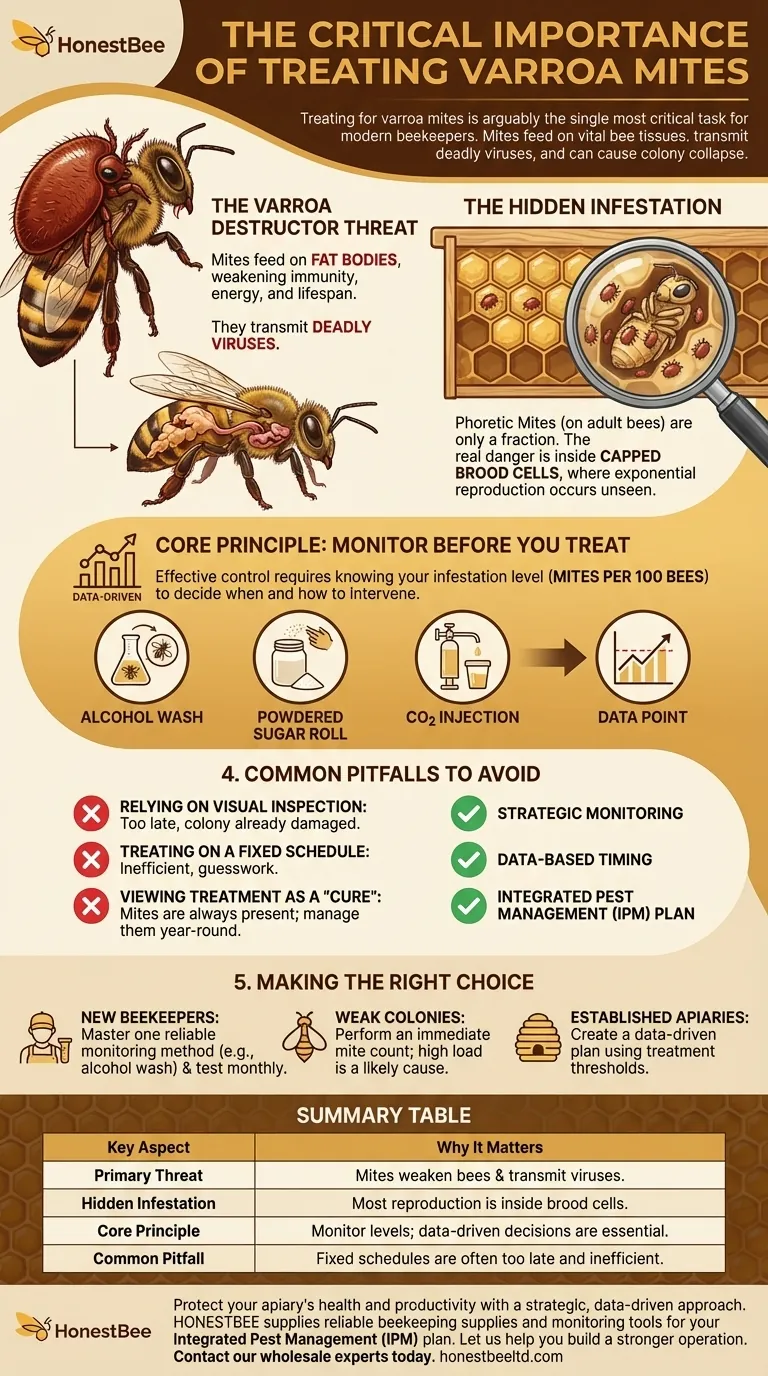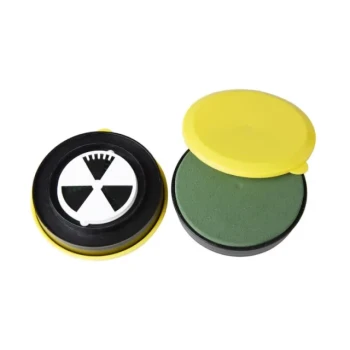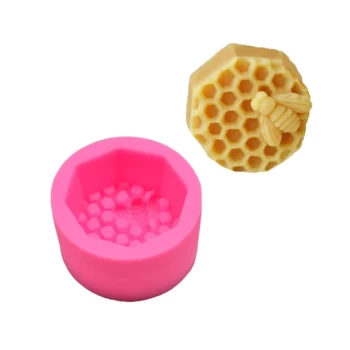Treating for varroa mites is arguably the single most critical task for modern beekeepers. These tiny external parasites feed on the vital fat body tissue of honey bees, weakening their immune systems and transmitting deadly viruses throughout the colony. Failing to manage varroa mite populations is not a viable option; without intervention, an infestation will almost certainly lead to the colony's collapse.
The core principle of varroa management is not simply treating, but constantly monitoring the mite population. Effective control comes from understanding your colony's specific infestation level and using that data to decide precisely when and how to intervene.
Understanding the Varroa Destructor Threat
Varroa mites (Varroa destructor) are more than just a simple pest. Their lifecycle and method of attack are uniquely damaging to honey bee colonies, making them a relentless and pervasive threat.
The Attack on a Bee's Vital Organ
Mites feed on the fat bodies of both adult bees and their developing young (brood). This organ is crucial, functioning much like the human liver.
The fat body is essential for a bee's immune response, energy storage, detoxification, and overwintering survival. A bee with a damaged fat body is weaker, sicker, and has a significantly shorter lifespan.
The Hidden Infestation
The mites you may occasionally see on the backs of adult bees are known as phoretic mites. These represent only a fraction of the total mite population.
The real danger lies unseen. The majority of mites, and all of their reproduction, occurs inside the capped brood cells where the young bees develop. A mated female mite enters a cell before it is capped, laying multiple offspring that feed on the developing pupa, ensuring the problem multiplies exponentially out of sight.
The Core Principle: Monitor Before You Treat
Because the majority of the mite infestation is hidden from view, visual inspection is an unreliable way to gauge the health of your colony. A proactive management plan is built on gathering data through systematic monitoring.
Why Monitoring is Non-Negotiable
Monitoring provides a snapshot of the infestation level, typically measured as the number of mites per 100 bees. This data is the only way to know if your mite population is below, at, or above the treatment threshold.
Failing to monitor means you are flying blind. You risk either treating too late when the colony is already irreversibly damaged, or treating unnecessarily, which can be costly and stressful for the bees.
Methods for Gathering Data
Beekeepers have several standardized methods for measuring mite levels. Each one gives you the crucial data needed to make an informed management decision.
Common methods include the alcohol wash, the powdered sugar roll, and the CO2 injection method. These techniques provide a direct count of mites on a sample of adult bees, giving you the most accurate snapshot of your infestation level.
Common Pitfalls in Varroa Management
Effective management requires avoiding common but costly mistakes. Simply knowing mites are a problem is not enough; your approach must be strategic and consistent.
Relying on Visual Inspection
Waiting until you can easily see mites on your bees is a critical error. By the time mites are that numerous on adult bees, the infestation level within the brood is already severe and the colony may be too weak to save.
Treating on a Fixed Schedule
Treating on a fixed calendar date without monitoring is inefficient. Mite populations build at different rates depending on weather, location, and colony genetics. Treating without data means you are just guessing.
Viewing Treatment as a "Cure"
A single treatment is not a permanent solution. Treatments like oxalic acid are highly effective tools, but they are only one part of a year-round Integrated Pest Management (IPM) plan. Mites will always be present, and your goal is to manage their numbers, not seek a one-time eradication.
Making the Right Choice for Your Goal
Your approach to varroa management should be guided by your experience and specific goals. The underlying principle, however, remains the same: use data to take action.
- If you are a new beekeeper: Your primary focus should be mastering one reliable monitoring method (like an alcohol wash) and testing your colonies monthly during the main season.
- If your colonies seem weak or unproductive: Your first action should be to perform an immediate mite count, as a high varroa load is the most common cause of general colony decline.
- If you run an established apiary: Your goal is to create a data-driven plan that uses established treatment thresholds to guide your actions throughout the entire year.
Proactive monitoring and timely intervention are the cornerstones of responsible and successful beekeeping.
Summary Table:
| Key Aspect | Why It Matters |
|---|---|
| Primary Threat | Mites weaken bees' immune systems and transmit deadly viruses, leading to colony collapse. |
| Hidden Infestation | Most mites reproduce inside capped brood cells, making visual inspection unreliable. |
| Core Principle | Monitor mite levels before treating; data-driven decisions are essential for effective control. |
| Common Pitfall | Treating on a fixed schedule without monitoring is inefficient and often too late. |
Protect your apiary's health and productivity with the right equipment. A strategic, data-driven approach to varroa mite management is essential for commercial beekeepers and distributors. HONESTBEE supplies the reliable beekeeping supplies and monitoring tools you need to implement an effective Integrated Pest Management (IPM) plan. Let us help you build a stronger, more resilient operation. Contact our wholesale experts today to discuss your apiary's specific needs.
Visual Guide

Related Products
- Adjustable Formic and Acetic Acid Dispenser for Bee Mite Treatment
- Professional Bamboo Queen Isolation Cage
- Varroa Easy Check Mite Tester Kit Counter Alcohol Wash Jar
- Professional Galvanized Hive Strap with Secure Locking Buckle for Beekeeping
- Professional Plastic Queen Excluder for Modern Beekeeping
People Also Ask
- What does Chewed Down Brood (CDB) indicate in bee colonies? A Sign of Varroa Mite Infestation
- What are the symptoms of Varroa Mite Syndrome (VMS)? Recognizing the Signs of Colony Collapse
- How do Varroa mites spread between honey bee colonies? Stop Mite Transmission in Your Apiary
- What are some common predators and pests that target beehives? Protect Your Hives from Bears, Mites, and Beetles
- What is the optimal time for varroa mite control in nucs? Maximize Efficacy with Perfect Timing



















